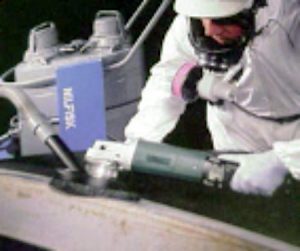 Lead exposure can occur during a variety of job activities. Lead is common in a wide range of materials including paints and other coatings, lead mortars, and base metals, which may be welded on or abrasive blasted. Lead presents a potentially serious occupational health hazard when the lead-containing particulates become airborne.
Lead exposure can occur during a variety of job activities. Lead is common in a wide range of materials including paints and other coatings, lead mortars, and base metals, which may be welded on or abrasive blasted. Lead presents a potentially serious occupational health hazard when the lead-containing particulates become airborne.
Exposure to lead occurs through breathing of lead dust, fumes, or mist and by ingestion of lead dust on cigarettes, chewing tobacco, make-up, or food.
Precautions that Workers Can Take to Avoid Getting Overexposed:
- Use safe work practices such as wetting down paints and coatings to keep dust out of the air;
- Change clothes and wash up before eating, drinking, or smoking. Eat, drink, and smoke only in clean areas;
- Use personal protective equipment like gloves, special clothing, and a respirator;
- Make sure the respirator fits and is worn and maintained properly; and
- Change clothes and wash up before going home.
- Lead dust on clothes or in the car could expose the family to lead. Children are more susceptible to lead than adults.
Lead may negatively affect the blood system, nervous system, kidneys, and reproductive organs. A worker who is exposed to lead above the action level must have a blood test to determine the amount of lead in the blood.
We’re all exposed to lead in some form or another. The important thing to remember is not to overexpose ourselves unnecessarily. Sometimes the best protection is being aware of the hazards and staying away from them.
IF YOU BREATHE LEAD…YOU COULD END UP DEAD!!
Download flyer: STOTW_804_Safely Working with Lead Download Spanish flyer: STOTW_804_Safely Working with Lead_esp

